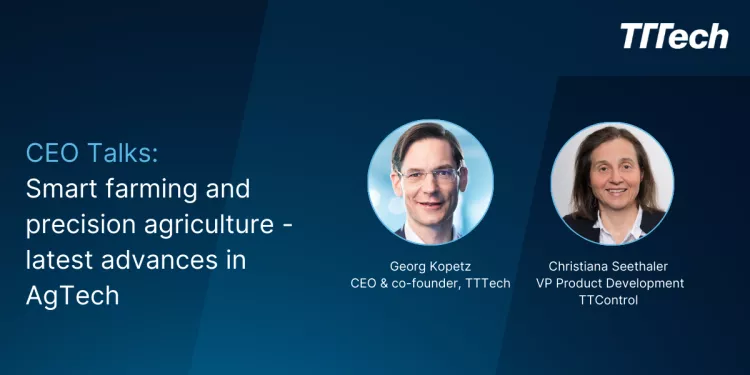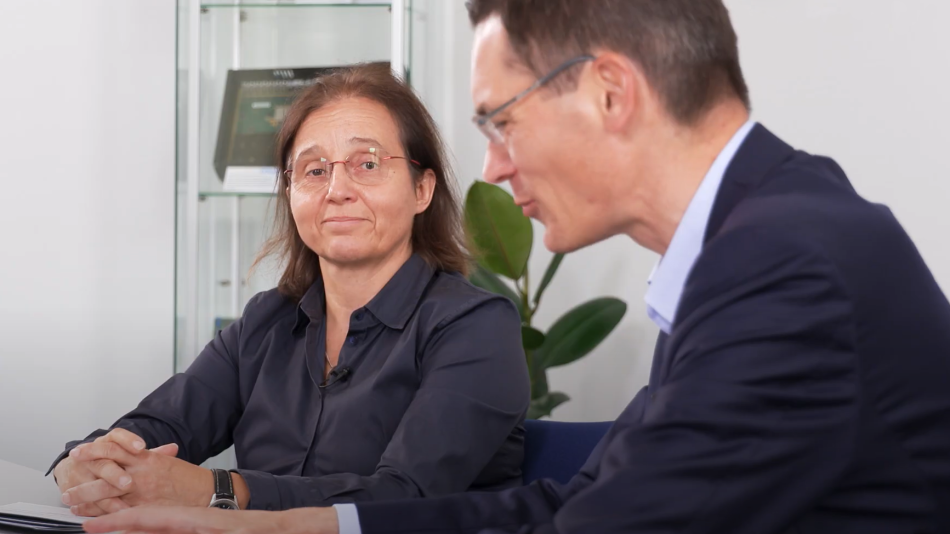
Welcome to this new edition of the CEO Talks about agricultural technology (AgTech), in particular smart farming and precision agriculture, which have a central place in TTTech’s strategy.
TTTech CEO and co-founder Georg Kopetz welcomed Christiana Seethaler, Vice President Product Development at TTControl, a joint venture of TTTech and HYDAC International. Christiana is an expert in high-performance control systems and advanced electronics for off-highway vehicles and contributes to the development of innovative electronic platforms for agricultural machinery, among many others.
Georg, why is TTTech interested in smart farming, precision agriculture, and AgTech in general?
Georg: Well, humanity is having an ever-larger impact on this planet. The global population is predicted to reach ten billion people by 2050, more and more of whom will be living in megacities. At the same time, we are facing human-induced global warming, which is diminishing biodiversity and bringing about more extreme weather events like flooding or droughts. All this leads to a decrease in arable land and a smaller variety of plants that can be grown. So how do we feed a growing population when resources are becoming more and more limited? Using digital technologies in agriculture could be one of the answers. We call this development “smart farming” or “precision agriculture” because technology allows for much more precise use of resources like water and pesticides. On the business side, we also know from several studies that connectivity and integration of cloud computing with machines can bring enormous economic benefits and add up to 500 billion US dollars to the global gross domestic product in the next years.
Christiana, could you explain what AgTech is all about? What exactly is smart farming and precision farming?
Christiana: The terms “smart farming” and “precision agriculture” are often used synonymously, but they have actually slightly different meanings. The goal of both is to increase the productivity of farmland while at the same time reducing the resources needed and also lowering the impact on the environment, which is crucial. So, precision farming is all about making farming processes more accurate and efficient. One example is fertilizer use. Traditionally, an equal amount of fertilizer is applied to the whole farm area. With smart technologies, you can use sensors that measure the nutrients in the soil and based on this data you can apply the right amount of fertilizer exactly where needed. The benefit is that less fertilizers are used, which saves costs, but, more importantly, it reduces the harmful impact that fertilizers can have on drinking water. Smart farming, on the other hand, refers to information technologies that support farmers in making decisions based on concrete data. Farm Management Information Systems, for example, are software platforms that collect, store, and analyze data from sensors, weather stations, tractors, and other agricultural machines and allow farmers to optimize resource usage and crop yield based on this data.
Subscribe to our newsletterand receive CEO talks directly to your inbox
Which enabling technologies do you see for smart farming and precision agriculture?
Christiana: Agricultural machinery will use more and more sensors, cameras, electronic control units, and, of course, software. Agricultural vehicles will become software-defined, like cars. Cloud connectivity is another trend. Many agricultural machines are already connected to the cloud, which allows them to upload data in real time to their Farm Management Information Systems, but also to update software in the vehicles, or perform remote diagnostics and maintenance.
Drones are also used in smart agriculture, e.g. for scanning the field using sensors. How do they exchange information with agricultural machinery on the ground?
Christiana: Typically, drones will take images or visual data. This data needs to be analyzed, for example, by AI or machine learning algorithms to check plants for diseases or assess their growth status and make decisions based on that data.
Georg: I think the role of drones is interesting in that they can provide more information to the machines on the ground and the more these machines “know” about their environment, the more farmers can do to protect the environment. They complement TTControl’s technologies inside the agricultural machines because they provide data to the learning algorithms. The connectivity between the machines is also vital because by gathering all that information in the cloud, farmers get a more complete picture of plant status which helps them to vastly increase crop yield.
Because the agricultural machinery industry is comparatively small, it often looks to other industries for new technologies to adopt. Which emerging trends are the most promising?
Christiana: There is a big hype around autonomous driving for cars, and this is clearly a trend that we also see in the agricultural industry. More and more robots are being developed and deployed that move autonomously and perform certain functions. One example would be robots for apple or strawberry picking that can locate the fruit and detect if it is ripe enough to be harvested. This also reduces food waste because crops can be harvested at exactly the right moment.

There is a trend towards smaller machines that may even be operating in swarms. Have you seen anything like that out in the field?
Christiana: We will definitely see a lot of smaller, lighter machines with the benefit that they will decrease the impact on the soil. So far, I have seen swarms of small autonomous farm robots only in research projects and the commercial introduction is certainly some years in the future. For many functions, like harvesting corn or wheat, the machine also needs to have a certain size and weight to work effectively.
Where do you see the role of humans in the journey towards smart agriculture? What new skill sets will farmers need?
Christiana: The farmer will probably become more of a remote controller and monitor of a variety of machines. Future farmers will definitely need a certain degree of IT knowledge and will rely much more on data to make decisions rather than based on their intuition.
Georg: I think the gut feeling of a good farmer will still be invaluable, but this intuition for nature will be complemented by data that also enable fact-based decision-making.
Many semi-autonomous machines still have the driver in the loop. Do you think operators may become fully remote someday soon?
Christiana: This will probably not be a rapid change but happen gradually, but it’s already happening in the industry. I think the agricultural sector will see full autonomy sooner than, say, the automotive sector, maybe even within the next five years or so. There is a shortage of skilled drivers able to operate these complex machines, which accelerates the movement towards autonomy.
As machines become connected to the cloud, concerns about cyberattacks increase. How important is cybersecurity in smart farming? How do our customers prepare for this?
Christiana: Cybersecurity is a highly relevant topic in our industry. Everyone knows that more regulations are coming up, but many companies are not prepared yet. This is both an opportunity and a threat. We are preparing our products to be ready for the European Union’s Cyber Resilience Act, which will come into force in 2027.
The Fusion AI is TTControl’s flagship product for the smart machinery market. Can you tell us a little bit more about that?
Georg: Christiana and her team have been working on this product tirelessly over the past few years and we are proud that it is now getting into production after we successfully introduced it at AGRITECHNICA last year. Fusion is a high-performance computing engine with an NXP processor that is also equipped with an AI accelerator from Hailo. It can be utilized as a display controller, an image processing device, a gateway to the cloud, and much more.
What can be the role of Fusion in smart agriculture?
Christiana: One example would be an application for weed removal. As a first step, a machine learning model needs to be trained to distinguish the crop plants from the weed using labeled images. This trained neural network can be loaded into our Fusion product that is mounted on the machine together with cameras connected to it. A connection to the cloud is no longer needed for the execution of the machine learning model. When the machine drives through the field, it captures the images of the plants in front of it with the cameras and the Fusion identifies the undesirable weeds in real-time with its AI accelerator executing the neural network. It also sends signals to the control units to remove the weed at the right position. When the weed is removed mechanically, the use of herbicides can be completely avoided.
Georg: So it’s a complete, intelligent control system with both, sensing inputs and actuation outputs. Sensing means that desirable plants can be distinguished from undesirable ones with the help of machine learning algorithms and vision systems (e.g. cameras). Mechanical actuation then destroys the weeds without harming the crops.
Which other upcoming activities are you planning in AgTech that you can already talk about?
Christiana: I’ve already talked about autonomy earlier and we currently have something in preparation that will move us further towards fully autonomous machines in the agricultural industry. We hope we’ll have more news soon!
Thank you very much for this interesting conversation. It looks like agriculture is becoming truly high-tech! We’re excited to hear more about TTControl’s solutions going forward.